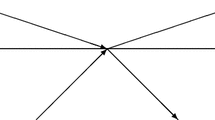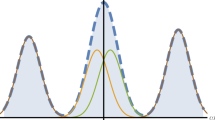Abstract
Examining the notion of wavefunction collapse (WFC) in quantum measurements, which came again to be in question in the recent debate on the quantum Zeno effect, we remark that WFC is realized only through decoherence among branch waves by detection, after a spectral decomposition process from an initial object wavefunction to a superposition of branch waves corresponding to relevant measurement propositions. We improve the definition of the decoherence parameter, so as to be fitted to general cases, by which we can quantitatively estimate the degree of WFC given by detectors. Finally, we briefly discuss whether two special detector models, with very huge and very small degrees of freedom, can provoke WFC.
Similar content being viewed by others
REFERENCES
For example, see J. von Neumann, Mathematische Grundlagen der Quantum Mechanik (Springer, Berlin, 1932). [English translation: Mathematical Foundations of Quantum Mechanics, E. T. Beyer, trans. (Princeton University Press, Princeton, NJ, 1955) ].
Also see M. Namiki, S. Pascazio, and H. Nakazato, Decoherence and Quantum Measurements (World Scientific, Singapore, 1997).
There are many earlier papers, by L. A. Khalfin, B. Misra, E. C. G. Sudarshan, and others, on the quantum Zeno effect. See Ref. 2 and a review article by D. Home and M. A. P. Whitaker, Ann. Phys. (N.Y.) 258, 237 (1997).
R. J. Cook, Phys. Scripta T21, 49 (1988).
W. M. Itano, D. J. Heinzen, J. J. Bollinger, and D. J. Wineland, Phys. Rev. A 43, 2295 (1990).
S. Machida and M. Namiki, Prog. Theor. Phys. 63, 1457, 1833 (1980).
T. Pertrosky, S. Tasaki, and I. Prigogine, Phys. Lett. A 151, 109 (1990); Physica A 170, 306 (1991).
S. Inagaki, M. Namiki, and T. Tajiri, Phys. Lett. A 166, 5 (1992). As for observation of the quantum Zeno effect making use of neutron beams, see the papers by H. Rauch, M. Namiki, S. Pascazio, H. Nakazato, and others. Also, refer to Ref. 2.
H. Rauch, personal communication.
H. Kaiser, R. Clothier, S. A. Werner, H. Rauch, and H. Wölwitsh, Phys. Rev. A 45, 31 (1992).
H. Nakazato, M. Namiki, S. Pascazio, and Y. Yamanaka, Phys. Lett. A 222, 130 (1996).
Rights and permissions
About this article
Cite this article
Namiki, M. Decoherence and Wavefunction Collapse in Quantum Measurements. Foundations of Physics 29, 457–464 (1999). https://doi.org/10.1023/A:1018827217752
Issue Date:
DOI: https://doi.org/10.1023/A:1018827217752




